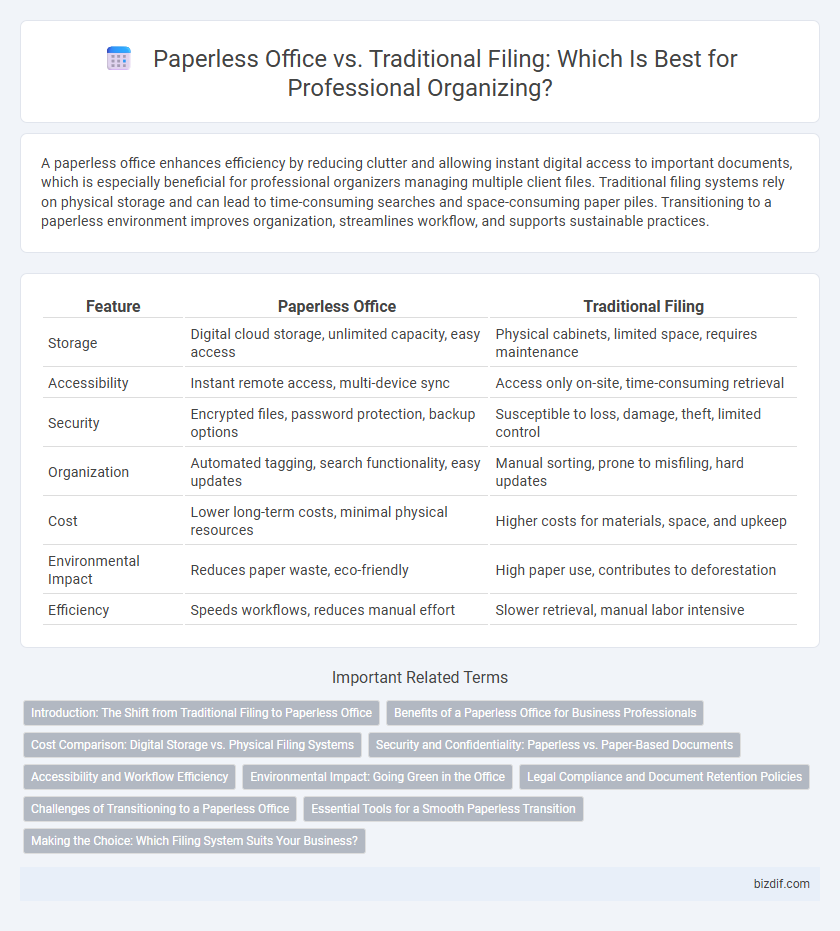A paperless office enhances efficiency by reducing clutter and allowing instant digital access to important documents, which is especially beneficial for professional organizers managing multiple client files. Traditional filing systems rely on physical storage and can lead to time-consuming searches and space-consuming paper piles. Transitioning to a paperless environment improves organization, streamlines workflow, and supports sustainable practices.
Table of Comparison
| Feature | Paperless Office | Traditional Filing |
|---|---|---|
| Storage | Digital cloud storage, unlimited capacity, easy access | Physical cabinets, limited space, requires maintenance |
| Accessibility | Instant remote access, multi-device sync | Access only on-site, time-consuming retrieval |
| Security | Encrypted files, password protection, backup options | Susceptible to loss, damage, theft, limited control |
| Organization | Automated tagging, search functionality, easy updates | Manual sorting, prone to misfiling, hard updates |
| Cost | Lower long-term costs, minimal physical resources | Higher costs for materials, space, and upkeep |
| Environmental Impact | Reduces paper waste, eco-friendly | High paper use, contributes to deforestation |
| Efficiency | Speeds workflows, reduces manual effort | Slower retrieval, manual labor intensive |
Introduction: The Shift from Traditional Filing to Paperless Office
The shift from traditional filing systems to a paperless office enhances efficiency by minimizing physical storage and reducing retrieval time for documents. Digital organization tools enable seamless access, searchability, and secure backup, revolutionizing workflow management in professional settings. Embracing a paperless approach supports sustainability goals and lowers operational costs compared to conventional filing cabinets and paper-heavy processes.
Benefits of a Paperless Office for Business Professionals
A paperless office significantly enhances efficiency by reducing physical clutter and enabling quick access to digital documents through organized cloud storage systems. Business professionals benefit from improved collaboration and real-time updates, which streamline workflows and reduce the risk of lost or misplaced files. Cost savings on office supplies and secure digital archiving also support sustainability goals while maintaining compliance with data protection regulations.
Cost Comparison: Digital Storage vs. Physical Filing Systems
Digital storage in a paperless office significantly reduces costs by eliminating expenses for physical materials such as filing cabinets, paper, and ink, while also lowering space requirements and maintenance overhead. Traditional filing systems incur ongoing costs related to purchasing supplies, renting storage space, and labor-intensive document management. Cloud-based solutions and affordable digital storage options provide scalable, cost-effective alternatives that enhance efficiency and reduce the total cost of ownership compared to physical filing methods.
Security and Confidentiality: Paperless vs. Paper-Based Documents
Paperless offices use encrypted digital storage and multi-factor authentication to secure sensitive information, reducing the risk of unauthorized access compared to traditional filing. Physical documents in paper-based systems are vulnerable to theft, loss, and damage, making confidentiality harder to guarantee. Digital access logs and regular backups further enhance data protection, ensuring audit trails and quick recovery from breaches or disasters.
Accessibility and Workflow Efficiency
A paperless office enhances accessibility by enabling instant digital retrieval of documents through cloud-based storage and advanced search functions, eliminating the delays associated with physical file searches. Workflow efficiency improves significantly as digital organization reduces clutter, streamlines collaboration across teams, and automates routine tasks such as filing and document sharing. In contrast, traditional filing systems often hinder productivity due to manual handling, limited access points, and increased risk of document misplacement or damage.
Environmental Impact: Going Green in the Office
Embracing a paperless office drastically reduces paper consumption, minimizing deforestation and waste accumulation compared to traditional filing systems. Digital document management significantly lowers office carbon footprints by decreasing the need for physical storage and reducing energy used in paper production and disposal. Transitioning to electronic files supports sustainable business practices and contributes to a healthier environment through reduced landfill contributions and lower resource depletion.
Legal Compliance and Document Retention Policies
Transitioning to a paperless office enhances legal compliance by enabling precise, automated document retention and secure digital archiving in accordance with regulatory standards such as GDPR and HIPAA. Traditional filing systems pose risks of misplacement and slower retrieval, complicating adherence to mandated retention schedules and audit trails required by legal frameworks. Implementing electronic document management systems (EDMS) streamlines policy enforcement, reduces physical storage costs, and facilitates rapid access during compliance audits or litigation.
Challenges of Transitioning to a Paperless Office
Transitioning to a paperless office presents challenges such as data security concerns and the need for reliable digital backup systems to prevent information loss. Employees often require comprehensive training to adapt to new software, which can temporarily reduce productivity and increase resistance to change. Additionally, integrating existing paper documents into digital formats demands significant time and resources, complicating workflow continuity during the transition.
Essential Tools for a Smooth Paperless Transition
Essential tools for a smooth paperless transition include robust document management software such as Microsoft SharePoint or Google Workspace that enable secure cloud storage and easy access. High-quality scanners with OCR capabilities like the Fujitsu ScanSnap streamline digitization by converting paper documents into searchable digital files. Implementing encrypted backup solutions and digital signature platforms ensures data security and maintains compliance during the shift from traditional filing systems to a paperless office environment.
Making the Choice: Which Filing System Suits Your Business?
Choosing between a paperless office and traditional filing depends on your business's size, workflow, and regulatory requirements. Digital filing systems streamline document retrieval, reduce physical storage costs, and enhance data security with cloud backup options. Traditional filing may benefit industries with stringent legal documentation needs or those preferring tactile document management for audit trails.
Paperless office vs Traditional filing Infographic

 bizdif.com
bizdif.com